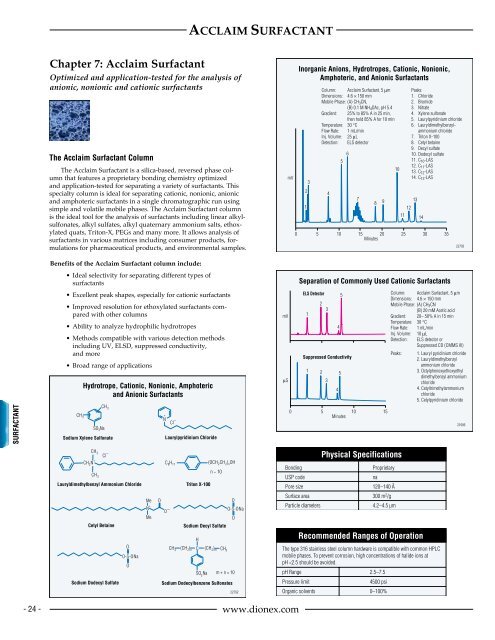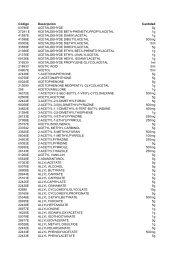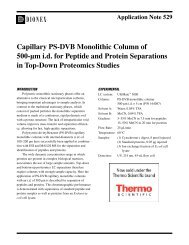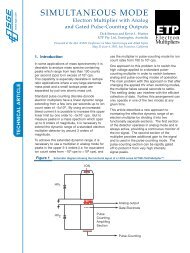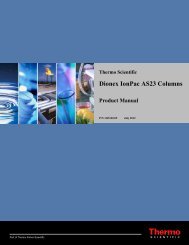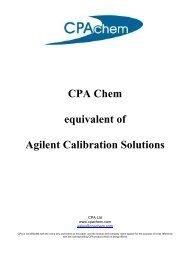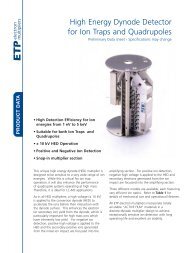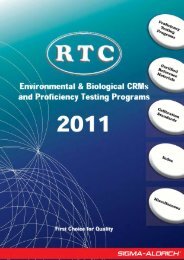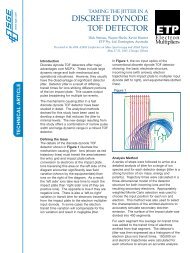ACCLAIM oa - Cromlab
ACCLAIM oa - Cromlab
ACCLAIM oa - Cromlab
Create successful ePaper yourself
Turn your PDF publications into a flip-book with our unique Google optimized e-Paper software.
Acclaim SurfactantChapter 7: Acclaim SurfactantOptimized and application-tested for the analysis ofanionic, nonionic and cationic surfactantsThe Acclaim Surfactant ColumnThe Acclaim Surfactant is a silica-based, reversed phase columnthat features a proprietary bonding chemistry optimizedand application-tested for separating a variety of surfactants. Thisspecialty column is ideal for separating cationic, nonionic, anionicand amphoteric surfactants in a single chromatographic run usingsimple and volatile mobile phases. The Acclaim Surfactant columnis the ideal tool for the analysis of surfactants including linear alkylsulfonates,alkyl sulfates, alkyl quaternary ammonium salts, ethoxylatedquats, Triton-X, PEGs and many more. It allows analysis ofsurfactants in various matrices including consumer products, formulationsfor pharmaceutical products, and environmental samples.mVInorganic Anions, Hydrotropes, Cationic, Nonionic,Amphoteric, and Anionic Surfactants213Column: Acclaim Surfactant, 5 µmDimensions: 4.6 × 150 mmMobile Phase: (A) CH 3 CN,(B) 0.1 M NH 4 OAc, pH 5.4Gradient: 25% to 85% A in 25 min,then hold 85% A for 10 minTemperature: 30 °CFlow Rate: 1 mL/minInj. Volume: 25 µLDetection: ELS detector45670 5 10 15 20 25 30 35Minutes89101112Peaks:1. Chloride2. Bromide3. Nitrate4. Xylene sulfonate5. Laurylpyridinium chloride6. Lauryldimethylbenzylammoniumchloride7. Triton X-1008. Cetyl betaine9. Decyl sulfate10. Dodecyl sulfate11. C 10 -LAS12. C 11 -LAS13. C 12 -LAS14. C 13 -LAS131422793Benefits of the Acclaim Surfactant column include:• Ideal selectivity for separating different types ofsurfactants• Excellent peak shapes, especially for cationic surfactants• Improved resolution for ethoxylated surfactants comparedwith other columns• Ability to analyze hydrophilic hydrotropes• Methods compatible with various detection methodsincluding UV, ELSD, suppressed conductivity,and more• Br<strong>oa</strong>d range of applicationsHydrotrope, Cationic, Nonionic, Amphotericand Anionic SurfactantsmVµSSeparation of Commonly Used Cationic SurfactantsELS Detector123Suppressed Conductivity1 234455Column: Acclaim Surfactant, 5 µmDimensions: 4.6 × 150 mmMobile Phase: (A) CH 3 CN(B) 20 mM Acetic acidGradient: 20– 50% A in 15 minTemperature: 30 °CFlow Rate: 1 mL/minInj. Volume: 10 µLDetection: ELS detector orSuppressed CD (CMMS III)Peaks: 1. Lauryl pyridinium chloride2. Lauryldimethylbenzylammonium chloride3. Octylphenoxyethoxyethyldimethylbenzyl ammoniumchloride4. Cetyltrimethylammoniumchloride5. Cetylpyridinium chlorideSURFACTANTCH 3CH 3SO 3 NaSodium Xylene Sulfonate+N Cl–Laurylpyridinium Chloride0 510 15Minutes21086CH 3 –ClCH 2 N +CH 3Lauryldimethylbenzyl Ammonium ChlorideCetyl BetaineSodium Dodecyl SulfateOO-S-ONaOMe+NMeC 8 H 17(OCH 2 CH 2 ) n OHn ~ 10Triton X-100OOO-S-ONaO–OSodium Decyl SulfateHCH 3(CH 2 ) n C (CH 2 ) m CH 3SO Na m + n = 103Sodium Dodecylbenzene Sulfonates22792BondingUSP codePore sizePhysical SpecificationsProprietaryna120–140 ÅSurface area 300 m 2 /gParticle diameters 4.2–4.5 µmRecommended Ranges of OperationThe type 316 stainless steel column hardware is compatible with common HPLCmobile phases. To prevent corrosion, high concentrations of halide ions atpH


